Codes and Standards
US Dept. of Energy Updates Commercial Building Model Energy Standard

A Dept. of Energy analysis found that the 2022 standard would likely result in greater energy efficiency than the 2019 version.
Photo by Carol Highsmith/Library of Congress/public domain
(slightly cropped from original)
The latest ANSI/ASHRAE/IES energy standard for sites and buildings except low-rise residential structures would lead to greater energy efficiency in commercial buildings, according to a U.S. Dept. of Energy determination published March 6 in the Federal Register.
New commercial buildings meeting the requirements of ANSI/ASHRAE/IES Standard 90.1-2022 would see an average 9.8% in site energy savings compared to those that only meet the 2019 standard, an agency analysis found. It also projects an average of 9.4% in source energy savings, 8.9% in energy cost savings and 9.3% in carbon emissions savings when using the 2022 standard compared to the 2019 version.
The 2022 version of standard 90.1 adds for the first time a minimum prescriptive requirement for on-site renewable energy. Other highlights include an optional mechanical system performance path and requirements to address thermal bridging impacts.
Of the 89 addenda published in the 2022 standard, DOE analysts expect 39 would decrease energy use and the rest would have no direct impact. None of the addenda are expected to increase energy use.
The agency's Pacific Northwest National Laboratory performed the analysis.
Ginger Scoggins, ASHRAE president, said in a statement that the DOE determination “further solidifies Standard 90.1 as the cornerstone for achieving energy efficiency goals and ultimately moves us closer to widescale, global building decarbonization of the built environment.”
Under the Energy Conservation and Production Act, publication of the determination sets a two-year deadline for states to review their commercial building energy codes and update them as needed to meet or exceed the standard in terms of energy efficiency.
No states have adopted 90.1-2022 yet, according to department records, but an ASHRAE spokesperson says Oregon and New York are in the process of doing so.




